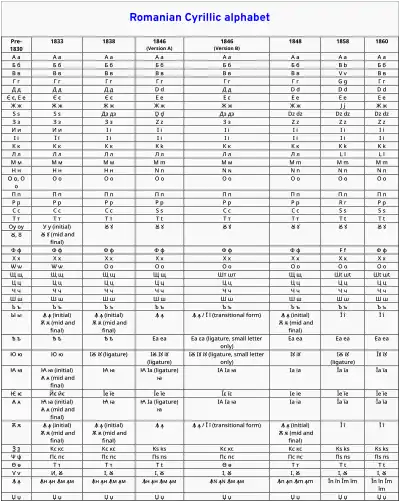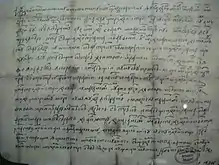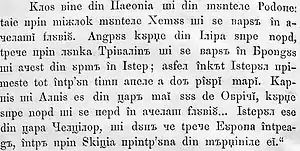Romanian Cyrillic alphabet
The Romanian Cyrillic alphabet is the Cyrillic alphabet that was used to write the Romanian language & Old Church Slavonic before the 1860s, when it was officially replaced by a Latin-based Romanian alphabet. Cyrillic remained in occasional use until the 1920s, mostly in Russian-ruled Bessarabia.[1]
| Romanian Cyrillic | |
|---|---|
 | |
| Script type | |
Time period | 14th–19th centuries |
| Languages | Romanian |
| Related scripts | |
Parent systems | Phoenician alphabet
|
Sister systems | Early Cyrillic alphabet |
From the 1830s until the full adoption of the Latin alphabet, the Romanian transitional alphabet was in place, combining Cyrillic and Latin letters, and including some of the Latin letters with diacritics that remain in the modern Romanian alphabet.[2] The Romanian Orthodox Church continued using the alphabet in its publications until 1881.[3]
The Romanian Cyrillic alphabet is not the same as the Moldovan Cyrillic alphabet (which is based on the modern Russian alphabet) that was used in the Moldavian SSR for most of the Soviet era and that is still used in Transnistria.
Table of correspondence
| The Cyrillic script | |||||||||||||||||||||||||||||||||||||||||||||||||||||||||||||||||||||||||||||||||||||||||||||||||||||||||||||||||||||||||||||||||||||||||||||||||||||||||||||||||||||||||||||||||||||||||||||||||||||||||||||||||
|---|---|---|---|---|---|---|---|---|---|---|---|---|---|---|---|---|---|---|---|---|---|---|---|---|---|---|---|---|---|---|---|---|---|---|---|---|---|---|---|---|---|---|---|---|---|---|---|---|---|---|---|---|---|---|---|---|---|---|---|---|---|---|---|---|---|---|---|---|---|---|---|---|---|---|---|---|---|---|---|---|---|---|---|---|---|---|---|---|---|---|---|---|---|---|---|---|---|---|---|---|---|---|---|---|---|---|---|---|---|---|---|---|---|---|---|---|---|---|---|---|---|---|---|---|---|---|---|---|---|---|---|---|---|---|---|---|---|---|---|---|---|---|---|---|---|---|---|---|---|---|---|---|---|---|---|---|---|---|---|---|---|---|---|---|---|---|---|---|---|---|---|---|---|---|---|---|---|---|---|---|---|---|---|---|---|---|---|---|---|---|---|---|---|---|---|---|---|---|---|---|---|---|---|---|---|---|---|---|---|
| Slavic letters | |||||||||||||||||||||||||||||||||||||||||||||||||||||||||||||||||||||||||||||||||||||||||||||||||||||||||||||||||||||||||||||||||||||||||||||||||||||||||||||||||||||||||||||||||||||||||||||||||||||||||||||||||
| |||||||||||||||||||||||||||||||||||||||||||||||||||||||||||||||||||||||||||||||||||||||||||||||||||||||||||||||||||||||||||||||||||||||||||||||||||||||||||||||||||||||||||||||||||||||||||||||||||||||||||||||||
| Non-Slavic letters | |||||||||||||||||||||||||||||||||||||||||||||||||||||||||||||||||||||||||||||||||||||||||||||||||||||||||||||||||||||||||||||||||||||||||||||||||||||||||||||||||||||||||||||||||||||||||||||||||||||||||||||||||
| |||||||||||||||||||||||||||||||||||||||||||||||||||||||||||||||||||||||||||||||||||||||||||||||||||||||||||||||||||||||||||||||||||||||||||||||||||||||||||||||||||||||||||||||||||||||||||||||||||||||||||||||||
| Archaic or unused letters | |||||||||||||||||||||||||||||||||||||||||||||||||||||||||||||||||||||||||||||||||||||||||||||||||||||||||||||||||||||||||||||||||||||||||||||||||||||||||||||||||||||||||||||||||||||||||||||||||||||||||||||||||
| |||||||||||||||||||||||||||||||||||||||||||||||||||||||||||||||||||||||||||||||||||||||||||||||||||||||||||||||||||||||||||||||||||||||||||||||||||||||||||||||||||||||||||||||||||||||||||||||||||||||||||||||||
The Romanian Cyrillic alphabet was close to the contemporary version of the Early Cyrillic alphabet of the Old Church Slavonic liturgical language.
| Letter | Numerical value |
Romanian Latin equivalent |
Transitional alphabet |
Moldovan Cyrillic equivalent |
Phoneme | Romanian name[4] |
Slavonic equiv. name |
|---|---|---|---|---|---|---|---|
| А а | 1 | a | A a | а | /a/ | az | азъ (azŭ) |
| Б Б | b | Б Б | б | /b/ | buche | бꙋкꙑ (buky) | |
| В в | 2 | v | В в | в | /v/ | vede | вѣдѣ (vĕdĕ) |
| Г г | 3 | gh (before e, i)
g (elsewhere) |
G g | г | /ɡ/ | glagol | глаголи (glagoli) |
| Д д | 4 | d | D d | д | /d/ | dobru | добро (dobro) |
| Є є, Е е[5] | 5 | e | E e | е | /e/ | est | єстъ (estŭ) |
| Ж ж | j | Ж ж | ж | /ʒ/ | juvete | живѣтє (živěte) | |
| Ѕ ѕ | 6 | dz | Ḑ ḑ | дз | /d͡z/ | zalu | ꙃѣло (dzělo) |
| З з | 7 | z | Z z | з | /z/ | zemle | зємл҄ꙗ (zemlja) |
| И и | 8 | i | I i | и | /i/ | ije | ижє (iže) |
| Й й[6] | i | Ĭ ĭ | й | /j/, /ʲ/ | |||
| І і[7] | 10 | i | I i | и | /i/ | i | и (i) |
| К к | 20 | ch (before e, i)
c (elsewhere) |
К к or K k | к | /k/ | kaku | како (kako) |
| Л л | 30 | l | Л л | л | /l/ | liude | людиѥ (ljudije) |
| М м | 40 | m | M m | м | /m/ | mislete | мꙑслитє (myslite) |
| Н н | 50 | n | N n | н | /n/ | naș | нашь (našĭ) |
| Ѻ ѻ, О о[5] | 70 | o | O o | о | /o̯/ | on | онъ (onŭ) |
| П п | 80 | p | П п | п | /p/ | pocoi | покои (pokoi) |
| Р р | 100 | r | Р р | р | /r/ | râță | рьци (rĭci) |
| С с | 200 | s | S s | с | /s/ | slovă | слово (slovo) |
| Т т | 300 | t | T t | т | /t/ | tferdu | тврьдо (tvrĭdo) |
| ОУ оу[5] | 400 | u | Ꙋ ꙋ[8] (Ȣ, ȣ, ɣ) | у | /u/ | upsilon | ꙋкъ (ukŭ) |
| Оу Ȣ, У Ȣ[5] | ucu | ||||||
| Ф ф | 500 | f | F f | ф | /f/ | fârta | фрьтъ (frĭtŭ) |
| Х х | 600 | h | Х х | х | /h/ | heru | хѣръ (xěrŭ) |
| Ѡ ѡ[9] | 800 | o | O o | о | /o/ | omega | отъ (otŭ) |
| Щ щ | șt | Щ щ | шт | /ʃt/ | ștea | ща (šta) | |
| Ц ц | 900 | ț | Ц ц | ц | /t͡s/ | ți | ци |
| Ч ч | 90 | c (before e, i)
ci (elsewhere) |
Ч ч | ч | /t͡ʃ/ | cervu | чрьвь (črĭvĭ) |
| Ш ш | ș | Ш ш | ш | /ʃ/ | șa | ша (ša) | |
| Ъ ъ | ă, ŭ[10] | Ъ ъ | э | /ə/ | ier | ѥръ (jerŭ) | |
| Ы ы, Ꙑ ꙑ | â, î[10] | Î î | ы | /ɨ/ | ieri | ѥрꙑ (jery) | |
| Ь ь | ă, ŭ, ĭ[10] | Ꙋ̆ ꙋ̆ | ь | — | ѥрь (jerĭ) | ||
| Ѣ ѣ | ea | Ea ea | я | /e̯a/ | eati(u) | ѣть (ětĭ) | |
| Ю ю | iu | Ĭꙋ ĭꙋ | ю | /ju/ | Io / iu | ю (ju) | |
| Ꙗ ꙗ[5] | ia | Ĭa ĭa | иа | /ja/ | ia | ꙗ (ja) | |
| Ѥ ѥ[5] | ie | Ĭe ĭe | ие | /je/ | ѥ (je) | ||
| Ѧ ѧ | ĭa, ea[10] | Ĭa ĭa, Ea ea | я | /ja/ | ia | ѧсъ (ęsŭ) | |
| Ѫ ѫ | î | Î î | ы | /ɨ/ | ѫсъ (ǫsŭ) | ||
| Ѯ ѯ[11] | 60 | x | Ks ks | кс | /ks/ | csi | ѯи (ksi) |
| Ѱ ѱ[11] | 700 | ps | Пs пs | пс | /ps/ | psi | ѱи (psi) |
| Ѳ ѳ[11] | 9 | th, ft | T t, Ft ft | т, фт | /t/ and approx. /θ/ or /f/ | thita | фита (fita) |
| Ѵ ѵ[11] | 400 | i, u | I i; Ꙋ ꙋ | и, у | /i/, /y/, /v/ | ижица (ižica) | |
| Ꙟ ꙟ, ↑ ↑ | în îm | În în Îm îm | ын, ым | /ɨn/, /ɨm/ | în | ||
| Џ џ | g (before e, i)
gi (elsewhere) |
Џ џ | ӂ | /d͡ʒ/ | gea |
Unregulated transitional alphabets
Starting with the 1830s and ending with the official adoption of the Latin alphabet, there were no regulations for writing Romanian, and various alphabets using Cyrillic and Latin letters, besides the mid-transitional version in the table above, were used, sometimes two or more of them in a single book. The following table shows some of the many alphabets used in print.
| Pre-1830 | 1833[12] | 1838[13] | 1846 (1)[14] | 1846 (2)[15] | 1848[16] | 1858[17] | 1860[18] |
|---|---|---|---|---|---|---|---|
| А а | А а | А а | А а | А а | А а | A a | A a |
| Б Б | Б Б | Б Б | Б Б | Б Б | Б Б | B b | Б Б |
| В в | В в | В в | В в | В в | В в | V v | В в |
| Г г | Г г | Г г | Г г | Г г | Г г | G g | Г г |
| Д д | Д д | Д д | D d | Д д | D d | D d | D d |
| Є є, Е e | Є є | Є є | E e | Ε ε | E e | E e | E e |
| Ж ж | Ж ж | Ж ж | Ж ж | Ж ж | Ж ж | J j | Ж ж |
| Ѕ ѕ | Ѕ ѕ | Дз дз | Ḑ ḑ | Дз дз | Dz dz | Dz dz | Dz dz |
| З з | З з | З з | Z z | З з | Z z | Z z | Z z |
| И и | И и | I i | I i | І і | I i | I i | I i |
| І і | Ї ї | I i | I i | І і | I i | I i | I i |
| К к | К к | К к | K k | К к | К к | K k | K k |
| Л л | Л л | Л л | Л л | Л л | Л л | L l | L l |
| М м | М м | М м | M m | М м | M m | M m | M m |
| Н н | Н н | Н н | N n | N ɴ | N n | N n | N n |
| Ѻ ѻ, О o | О о | О о | O o | О о | О о | О о | O о |
| П п | П п | П п | П п | П п | П п | П п | П п |
| Р р | Р р | Р р | Р р | Р р | Р р | R r | Р р |
| С с | С с | С с | S s | С с | С с | S s | S s |
| Т т | Т т | Т т | T t | Т т | Т т | T t | T t |
| Оу оу | У у (initial) Ꙋ ꙋ (mid and final) |
Ꙋ ꙋ | Ꙋ ꙋ | Ꙋ ꙋ | Ꙋ ꙋ | Ꙋ ꙋ | Ꙋ ꙋ |
| Ꙋ, ȣ | |||||||
| Ф ф | Ф ф | Ф ф | Ф ф | Ф ф | Ф ф | F f | Ф ф |
| Х х | Х х | Х х | Х х | Х х | Х х | Х х | Х х |
| Ѡ ѡ | Ѡ ѡ[19] | О о | O o | О о | O o | О о | О о |
| Щ щ | Щ щ | Щ щ | Щ щ | Шт шт | Щ щ | Шt шt | Шt шt |
| Ц ц | Ц ц | Ц ц | Ц ц | Ц ц | Ц ц | Ц ц | Ц ц |
| Ч ч | Ч ч | Ч ч | Ч ч | Ч ч | Ч ч | Ч ч | Ч ч |
| Ш ш | Ш ш | Ш ш | Ш ш | Ш ш | Ш ш | Ш ш | Ш ш |
| Ъ ъ | Ъ ъ | Ъ ъ | Ъ ъ | Ъ ъ | Ъ ъ | Ъ ъ | Ъ ъ |
| Ы ы | Ꙟ ꙟ (initial) Ѫ ѫ (mid and final) |
Ꙟ ꙟ (initial) Ѫ ѫ (mid and final) |
Ꙟ ꙟ | Ꙟ ꙟ / Î î (transitional form) | Ꙟ ꙟ (initial) Ѫ ѫ (mid and final) |
Î î | Î î |
| Ѣ ѣ | Ѣ ѣ | Ѣ ѣ | Ea ea | Εа εа (ligature, small letter only) | Ea ea | Ea ea | Ea ea |
| Ю ю | Ю ю | IꙊ iꙋ (ligature) | IꙊ Iꙋ iꙋ (ligature) | IꙊ Iꙋ іꙋ (ligature, small letter only) | Iꙋ iꙋ | IꙊ iꙋ (ligature) | Ĭꙋ ĭꙋ |
| Ꙗ ꙗ | Ꙗ ꙗ (initial) Ѧ ѧ (mid and final) |
Ꙗ ꙗ | Ꙗ Iа (ligature) ꙗ | IА Iа ꙗ | Ia ia | Ĭa ĭa | Ĭa ĭa |
| Ѥ ѥ | Йє йє | Ĭe ĭe | Ĭe ĭe | Ĭε ĭε | Ie ie | Ĭe ĭe | Ĭe ĭe |
| Ѧ ѧ | Ꙗ ꙗ (initial) Ѧ ѧ (mid and final) |
Ꙗ ꙗ | Ꙗ Iа (ligature) ꙗ | IА Iа ꙗ | Ia ia | Ĭa ĭa | Ĭa ĭa |
| Ѫ ѫ | Ꙟ ꙟ (initial) Ѫ ѫ (mid and final) |
Ꙟ ꙟ (initial) Ѫ ѫ (mid and final) |
Ꙟ ꙟ | Ꙟ ꙟ / Î î (transitional form) | Ꙟ ꙟ (initial) Ѫ ѫ (mid and final) |
Î î | Î î |
| Ѯ ѯ | Кс кс | Кс кс | Ks ks | Кс кс | Кс кс | Ks ks | Ks ks |
| Ѱ ѱ[11] | Пс пс | Пс пс | Пs пs | Пс пс | Пс пс | Пs пs | Пs пs |
| Ѳ ѳ[11] | Т т | Т т | T t | Ѳ ѳ | Т т | T t | T t |
| Ѵ ѵ[11] | И, Ꙋ | I, Ꙋ | I, Ꙋ | І, Ꙋ | І, Ꙋ | I, Ꙋ | I, Ꙋ |
| Ꙟ ꙟ | Ꙟн ꙟн Ꙟм ꙟм | Ꙟн ꙟн Ꙟм ꙟм | Ꙟн ꙟн Ꙟм ꙟм | Ꙟⲛ ꙟⲛ Ꙟм ꙟм | Ꙟn ꙟn Ꙟm ꙟm | În în Îm îm | În în Îm îm |
| Џ џ | Џ џ | Џ џ | Џ џ | Џ џ | Џ џ | Џ џ | Џ џ |
Example of Romanian Cyrillic text
According to a document from the 1850s,[20] this is how the Romanian Lord's Prayer looked in Cyrillic script. Transcriptional values correspond to the above table.
| Тáтъʌь нѡ́сmрꙋ | Tatăl nostru |
|---|---|
|
Та́тъль но́стрꙋ ка́реле є҆́щй ꙟ҆ че́рюрй: сфн҃цѣ́скъсе нꙋ́меле тъ́ꙋ: |
Tatăl nostru, carele ești în ceriuri, sfințeascăse numele tău: |
.jpg.webp) Early 19th century Romanian Cyrillic alphabet (Alecsandri, 1863)
Early 19th century Romanian Cyrillic alphabet (Alecsandri, 1863) Usual letter formats and Romanian equivalents
Usual letter formats and Romanian equivalents The oldest surviving document in Romanian: Neacșu's Letter, a trader from Câmpulung, sent to the mayor of Brașov (1521)
The oldest surviving document in Romanian: Neacșu's Letter, a trader from Câmpulung, sent to the mayor of Brașov (1521) The Lord's Prayer, in an 1850s religious document
The Lord's Prayer, in an 1850s religious document Transitional alphabet (fragment of Dimitrie Bolintineanu's Călătorii pe Dunăre și în Bulgaria, 1858)
Transitional alphabet (fragment of Dimitrie Bolintineanu's Călătorii pe Dunăre și în Bulgaria, 1858)
See also
References
- Ileana-Stanca Desa, Dulciu Morărescu, Ioana Patriche, Adriana Raliade, Iliana Sulică, Publicațiile periodice românești (ziare, gazete, reviste). Vol. III: Catalog alfabetic 1919–1924, pp. 235–236, 264, 368, 374, 575, 708, 1024. Bucharest: Editura Academiei, 1987
- George Baiculescu, Georgeta Răduică, Neonila Onofrei, Publicațiile periodice românești (ziare, gazete, reviste). Vol. II: Catalog alfabetic 1907–1918. Supliment 1790–1906, pp. 763, 801, 810, 813, 832, 867. Bucharest: Editura Academiei, 1969
- Grigore Chiriță, Societatea din Principatele Unite Române în perioada constituirii statului național (1856-1866), p. 134. Bucharest: Editura Academiei Române, 2004, ISBN 978-973-270-984-9
- According to Costache Negruzzi, "Cum am învățat românește", first published in Curier de Ambe Sexe, I, nr. 22, p.337–343
- Initial vs. non-initial shapes: Є/Е, Ѻ/О, Оу/У, IA/Ѧ.
- Й is hardly a separate letter of the alphabet; the letters Ю, Ȣ and Ѡ also accept a brevity sign.
- In loanwords of Greek origin (or ones adopted through the Greek language), letters И and І correspond to eta and iota, respectively. In the words of Romanian origin and in Slavic loanwords, their usage follows pre-1917 Russian rules, namely, І before vowels, otherwise И.
- Book written in the transitional alphabet showing various letter forms
- The distinction of Ѡ and О is present not only in loanwords, but in Romanian words as well.
- Letters ĭ and ŭ represent a barely spoken/heard i or u.
- Letters Ѯ, Ѱ, Ѳ and Ѵ are used for copying Greek spelling of loanwords (especially for names and toponyms).
- Грамматикъ практїкъ романо-францозѧскъ [modernised: Grammatică practică romano-franțozească compusă dupre autorii clasici cei mai noi ... - George Vida]. Retrieved 2012-10-22.
- Filosofice și politice prin falule învățaturĭ morale - Dimitrie Țichindeal, Dositej Obradović. Retrieved 2012-10-22.
- Magazinu istoriku pentru Dacia - Treboniu A. Laurian, Nicolae Bălcescu. Retrieved 2012-10-22.
- Noul Testament al Domnuluī shī Mîntuītoruluī nostru Īīsus Khrīstos. Retrieved 2012-10-22.
- Biografia lui Viliam G. Shecspri dupe Le Fourneur: Urmată de Romeo cu ... - William Shakespeare. Retrieved 2012-10-22.
- Istoria Moldo-Romănieĭ: arătîndŭ neamurile de ċare s'aŭ loċuitŭ aceste ... - George Ioanid. Retrieved 2012-10-22.
- Cîntece naționale: Tipărite cu fondul d-lor librarĭ Pusu i Petriu. A treia ... - O. Dumitrescu. Retrieved 2012-10-22.
- -лѡр only
- File:Romanian-kirilitza-tatal-nostru.jpg